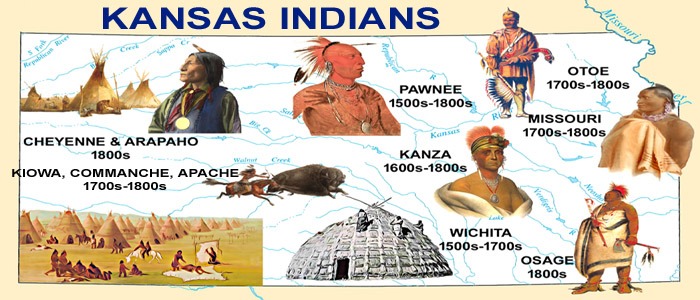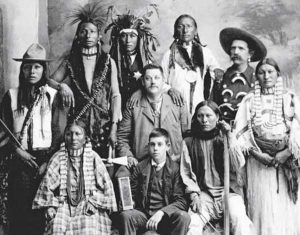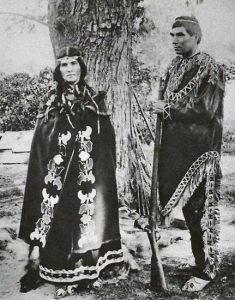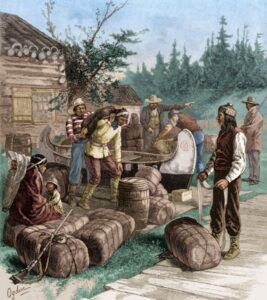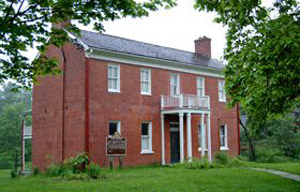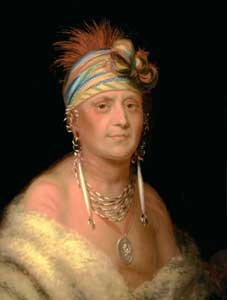Kansas Belonged to the Indians. During the years when the white men were traveling back and forth across Kansas, they were not making settlements here. The country remained in the undisputed possession of the Indians. The white men did not want it yet. They looked upon these vast prairies not as a resource but as so much land to be crossed in reaching places farther west. However, changing conditions in the states east of the Mississippi River made people begin to look upon Kansas in a different light. The country there was becoming thickly settled, and the people wanted the lands of the eastern Indians.
Removal of Eastern Indians to Kansas. Soon after the Louisiana Purchase was made, people began to talk of an Indian reserve, a state set aside for the Indians, and it was believed that these western prairies would be helpful in such a purpose. Nothing was done definitively until 1825 when the National Government began the “removal policy.” The eastern part of Kansas was occupied by two tribes of Indians, the Kanza, or Kaw as often called, north of the Kansas River, and the Osage south of it. In 1825, the National Government made treaties with these two tribes. Under the provisions of these treaties, each tribe retained only a small part of its territory, the rest being ceded to the Government. In return, the Indians would receive certain annual payments and be supplied with cattle, hogs, and farming implements. The government also provided them with blacksmiths and agriculture teachers. With these two tribes restricted to their reservations, a large part of eastern Kansas was left to be apportioned into reservations for Indians from the East. In 1830, Congress passed an act setting aside an Indian country, which included eastern Kansas. Then, the removal policy was carried out. Under this arrangement, the Government made treaties with the various eastern tribes by which they gave up their lands in exchange for certain tracts in the Indian country.
The Shawnee had come in 1825, and during the ten or twelve years following 1830, about 17 tribes were located on reservations in Kansas. Among these were the Ioway, Sac and Fox, Kickapoo, Delaware, Chippewa, Potawatomi, Wyandot, and Miami. By 1850, there was not a tribe left east of the Mississippi River. The Indians had all been moved to these western plains, and no white man could settle on any of the reservations without the consent of the Indians.
Indians Removed from Kansas. According to the treaties, the Indians were promised their land “so long as grass should grow or water run.” But it soon developed that the white men wanted Kansas, too. In 1854, the tribes were again transferred, this time to the Indian Territory, now Oklahoma, where the remnants of the various tribes remain.
Although Kansas was not used during those early years to make homes for white settlers, a few hundred people came. They were of three classes: fur traders, missionaries, and soldiers.
The Fur Traders. It is impossible to say when the first hunters and trappers came to these western plains, for they were generally obscure men, and little was known of their comings and goings, but they were the real pathfinders of the West. There are records of fur traders in the early 19th century who gradually went farther into the vast wilderness. The streams of travel across Kansas in the 1840s followed paths pointed out by the fur traders. The fur companies established many trading posts, which served as forts for protection against the Indians and as places where hunters and trappers could bring their furs. The fur companies employed some hunters and trappers, and others worked independently.
Many Indians also engaged in this trade and were often given tobacco, whisky, and weapons in exchange for their furs. In this way, much of the work of the missionaries was undone. In the earlier years, the hunters and trappers found many kinds of wild animals in Kansas: the buffalo, the wolf, the fox, the deer, the elk, and the antelope, and along the streams, the beaver, the otter, the mink, and the muskrat. Later, the main supply of fur came from the mountains, and the whole fur trade gradually moved west of Kansas.
Father Padilla, the First Missionary in Kansas. The attempt to civilize the Indians began in the days of the early explorers, and it was on Kansas soil that the first missionary’s life was lost in the cause. This man was Father Padilla, a Jesuit, who came with Francisco Vazquez de Coronado on his journey to Quivira. Father Padilla became very interested in the Quivira Indians and continued to do missionary work among them. His preaching was of short duration, however, for he was soon killed, whether by the Quivira or some other tribe is not known.
Kansas Missionaries of the Nineteenth Century. Centuries later, when Kansas became a part of the United States and was explored and traversed by white men, missionaries were among the first to arrive. They came to instruct the Indians in the Christian religion and to persuade them to adopt the customs of civilization. Reverend Isaac McCoy probably deserves the first mention of the many who came. He had spent many years at work among the Indians and strongly urged the removal policy. He believed that if they could live in a separate state, free from contact with the white race, the Indians could be civilized, and he gave his life to this work.
Jotham Meeker and his wife were among the most devoted of the missionaries. Many others, both men and women, placed the welfare of human beings above mere gain and endured the hardships of life among the Indians for the good they might do.
As soon as the eastern Indians were removed to Kansas, several missions were established by Baptist, Methodist, Presbyterian, Friends, and Catholic churches. The missionaries’ work was not confined to religious instruction. Schools were established, books were printed, the Indian girls were taught cooking and sewing, and the boys were taught farming and such trades as blacksmithing and carpentry.
The most noted mission in Kansas was the one established by the Methodist Church for the Shawnee Indians near the present site of Kansas City. This mission was opened in 1830 and continued for over a quarter of a century. It had a large tract of land, good buildings, and maintained a successful school. Reverend Thomas Johnson, who took a prominent part in early Kansas affairs, was in charge of the mission.
The Soldiers. The third class of people who came to early Kansas comprised soldiers. Their presence was necessary to protect the few white people against the Indians. The National Government established Fort Leavenworth in 1827 as headquarters for the troops. This was shortly after the beginning of the Santa Fe trade. During the 1840s, this fort was used as a base of supplies for the soldiers of the Mexican-American War and as an outfitting point for many of the California gold seekers and Mormon emigrants. Today, Fort Leavenworth is one of the most important national forts. Several other forts were established, including Fort Riley, Fort Dodge, Fort Scott, and Fort Hays, but all of these have been abandoned except Fort Riley.
Population of Pre-territorial Kansas. Kansas remained in possession of the Indians until 1854, when it was organized into a territory. With this date, a new era began. At this time, the white population consisted of about 1,200 people; half were soldiers, and the other half were connected with the trading posts and the missions.
Summary. When Kansas became a part of the United States, the country was occupied by four tribes of Indians. In 1825, the Kanza and Osage tribes ceded a large part of their lands to the Government, and the eastern quarter of the State was made a part of the Indian country by the Act of 1830. Following this, several eastern tribes were removed to reservations in Kansas. They remained until Kansas was organized as a territory in 1854, when they were moved to Indian Territory, now Oklahoma. During these years, there was much travel through the State, but up to 1854, the white population numbered only about 1,200. These people were of three classes: traders, missionaries, and soldiers.
Compiled & edited by Kathy Alexander/Legends of America, updated May 2025. Source: Arnold, Anna E.; The State of Kansas; Imri Zumwalt, state printer, Topeka, Kansas, 1919.
Also See:

